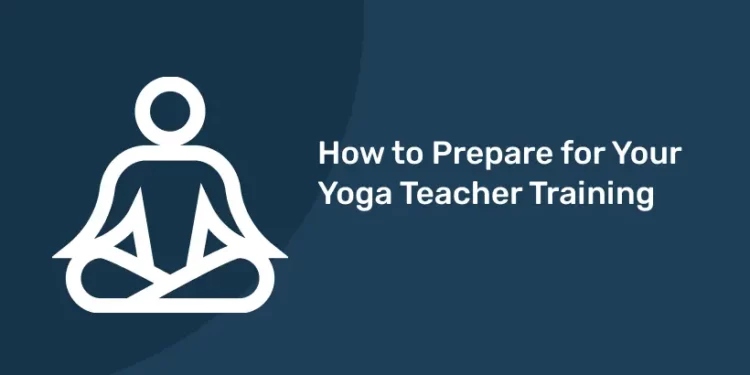Table of Contents
Naturally, as yoga gains more and more traction globally, so do the number of yoga instructors and training programs. Before enrolling in your first yoga teacher training program, there are a few things you should be aware of if you’re considering making your love of yoga your career You are going to have a million and one queries or concerns after enrolling in a Yoga Teacher Training (YTT), or if you are thinking about doing so for the upcoming year, you will be considering doing so. As you go on to the next phase of your yoga journey, there are so many things for you to think about and take into consideration that you are almost certain to forget one or two of them until the very time that you reach that level. I have compiled a list of items that need to be done in order to assist you in getting ready. Although this is by no means an exhaustive list, it ought to get you started in the right direction.
Yoga Teacher Training – Learn from Experienced Instructors! Get a Free Demo Here!
Do your homework
Finishing all of the required readings and work on the journal and essays. may seem like common sense advice, but I’ve found that there are always one or two yogis who take a relaxed approach to their practice and assume they can catch up to this part of the curriculum at some point in the future. In most cases, this takes place during the last week of the training, which may be a very stressful time because it is during this period that you are required to apply what you have learned about yoga philosophy to the creation of your first yoga class plan as well as your final exam. It is a waste of energy to try to accomplish both of those things at the same time. During your time as a yoga teacher trainee, you won’t have the ability to truly get ready for what comes ahead. In spite of what the title of this post may lead you to believe, no one can predict what will occur, nor can they predict how you will feel. When you decide to go on this adventure, keep in mind that the most you can accomplish is to do your best.
Set your intentions for the course
1: Which of these is the primary goal of yoga practice?
You should have your own personal goal(s), in addition to meeting all of the requirements of the training course.This is essential to both your health and your accomplishments in the teaching profession. Spending some time contemplating the motivations behind your desire to become a yoga instructor is time well spent. After that, make some notes about it in your journal. These will serve as a spiritual guide for you, bringing to mind the things that are most important to you. Because you will want to be as present as possible once you begin training, it is important that you take some time now to think about how you might want to use your training certification once it is finished. This is time well spent. Put out some feelers at locations that might be looking for a yoga instructor, and introduce yourself to those potential employers. You should schedule a meeting with them so that you can update them after you have obtained your certification.
Become a Certified Yoga Instructor
Yoga Teacher Training Course by Entri App: Master authentic yoga techniques, earn certification, and build a successful career as a professional yoga instructor.
Cleanse and Detox
For the purpose of your class, it is important that you are in the best physical shape that you can possibly be in. To jumpstart your metabolism and strengthen your immune system, it is time to put away the wine and chocolates and replace them with smoothies, vitamin water, juices, and berries. This will help you feel better and look better. It is important to maintain your energy levels, thus you should avoid skipping meals. Eat sensibly by beginning each day with a hearty meal, such as oats or eggs. If you want to be healthy, you should eat three meals a day that are high in nutrition and focus on foods like vegetables, fruit, and grains like quinoa and barley. Pulses and beans provide a nutritious alternative to meats, which are more difficult to digest and might make you feel heavier.
Yoga Teacher Training – Learn from Experienced Instructors! Get Free Demo Here!
Create a Home Practice
You should make it a goal to start a home yoga practice in addition to going to the yoga sessions that you normally go to. “If you are taking yoga classes but not practicing at home, you may be missing out on the best—and potentially most therapeutic—part of yoga,” Dr. Timothy McCall says in his book, Yoga as Medicine. When you turn your attention within and move at your own pace, the most profound work will take place in your personal practice. The home practice is just as vital as the studio practice because it introduces yoga into the house and integrates your lifestyle on and off the mat, both in and out of the studio.
Learn the key yoga poses for your specialism
The majority of yoga teacher training programmes require students to have prior knowledge of the asanas, including their benefits as well as their English and Sanskrit names. Some teacher training programmes even have a sort of examination, in which the teacher will call out an asana in Sanskrit, and the students will need to show the stance in order to be awarded the qualification. Before enrolling in a Yoga Teacher Training (YTT), students need to have a consistent yoga practise of at least one session per week for a minimum of two years in order to be eligible for most Yoga Alliance (YA) certifications. You should have a comprehensive understanding of asanas, including their names and the advantages they provide, at this point in time. Create a goal for yourself, much like you would at the beginning of the semester. Bring back to mind the reasons you do yoga and consider the reasons you might wish to teach it. This desire is helpful to return to if things become a bit challenging or overwhelming for a period of time. It’s possible that you’ll start your class with the goal of becoming a teacher once you finish it, but that by the time you’re halfway through, you’ll realize that the prospect of being a teacher isn’t quite as intriguing as it was when you initially considered it. And vice versa: you might believe that there is no way you will ever have the guts to stand up in front of a class and teach, but this is something that can change as well!
Become a Certified Yoga Instructor
Yoga Teacher Training Course by Entri App: Master authentic yoga techniques, earn certification, and build a successful career as a professional yoga instructor.
Practice non-judgement
This is not as simple as it sounds! It’s possible that you were the most skilled yogi in your class, but now you’re working alongside other yogis who are on the same level as you in terms of their capabilities. There are going to be some trainees who seem to have more style, more audacity, or who look better in yoga pants. The moment has come to get over yourself and move on. Due to the nature of humans, there will inevitably be competition between students and professors. This is something that cannot be avoided. Despite this, do not compromise the yogic principles and goals you have set for this training. According to K.S. Desikachar, “Yoga is the practice of observing yourself without judgment,” which is also a definition of yoga.
Think like a Yoga Teacher
Try to squeeze in as many yoga classes as you can, preferably with different instructors. Take notes on what they did well, what you might do differently, how the class reacted to the sequence, and so on. Start dreaming up your perfect yoga class by answering questions such as: who are your students, what is your relationship with them, what is their relationship with each other, and what one-of-a-kind or extraordinary gift would you provide to them? Spend some time putting yourself in the shoes of a student, and then try to imagine what it would be like to be an instructor instead. Start by visualizing yourself as a fully qualified YTT, and as the dates of the course grow closer, you should start believing it, since very soon, your desire will become a reality.
Yoga Teacher Training – Learn from Experienced Instructors! Get Free Demo Here!
Plan your future
It is never too early to start thinking about and making preparations to teach your first class; you should do both as soon as possible. A lot of studios end up hiring their students to work as instructors. If that is your goal, then you will want to do your absolute best in every single lesson and test that you take. References are equally vital, and even if you do not intend to teach with your trainer in the future, they are still a useful resource for future testimonials and referrals. If you want to run your own yoga studio or other type of business, you should make sure that the training you receive covers the commercial aspects of yoga in its entirety. YTT is also a fantastic time to establish a network of yoga instructors and trainers, so make sure to take advantage of the opportunity to share contact details with other participants. YTT is also an excellent time to develop a personal practice.
Prepare to be transformed
The first day of your yoga teacher training marks the beginning of your yoga adventure. In this sense, the amount of time you have spent practicing and your current skill level are both largely irrelevant considerations. YTT is an experience that will blow your mind and change your life. You are going to start perceiving and interacting with the environment in new ways. Because this is a magical moment, you should keep your mind and heart open to any and all possibilities and alterations. They are all essential components of the yogic way of living. Have a good time with it and smile a lot along the road.
Get Into Consistent Yoga Practice
You should work on getting into good physical shape before enrolling in a yoga instructor training program so that you will be able to keep up with the pace of your courses. Attending a yoga class a few times a week or practicing the asana consistently at home can help you prepare your body for more extensive instruction. This does not mean that you need to spend hours a day in serious yoga practice (you don’t want to damage yourself!). However, if you do this, it will help you prepare your body for more intense instruction. You can acquire a better sense of your own natural approach to teaching yoga if you take a variety of different yoga courses and learn from a variety of different yoga instructors. Taking a range of classes will inspire you in how you will teach your students, from giving music and sensory experiences to how you will work with students on an individual basis! While your teacher training will lead you in what you’ll be teaching and provide you with ways to assist you in running your classes, taking a variety of classes will also inspire you in what you’ll be teaching!
Yoga Teacher Training – Learn from Experienced Instructors! Get Free Demo Here!
Begin Journaling Regularly
Because the majority of yoga teacher training programs require participants to keep a regular journal as part of the requirements, doing so will assist you in allocating your time effectively once class begins. Most significantly, it will assist you in developing insights that are relevant to your path with yoga. You will be able to better understand your feelings and the challenges that may be preventing you from achieving your goals if you set aside time several times a week to give yourself the opportunity to relax, think clearly, and address any issues or concerns that may be on your mind.
Be Aware of Insecurities and Ego
Spend some time introspecting deeply within yourself before beginning the training to become a yoga instructor so that you may identify any internal roadblocks that could potentially slow you down during the process. It is necessary to be aware of the mental and emotional barriers that can limit your success. Whether you have anxieties about your abilities or body image, or conversely, your ego tells you that you already know everything, and the training is only a formality, it is important to be conscious of these emotional and mental roadblocks. Use the time you spend writing in your diary and meditating to reflect on your trip, the reasons you can achieve your goals, and the lessons you will pick up along the way.
Yoga Teacher Training – Learn from Experienced Instructors! Get Free Demo Here!
Related Articles
Yoga Teacher Training – Learn from Experienced Instructors! Get a Free Demo Here!
Become a Certified Yoga Instructor
Yoga Teacher Training Course by Entri App: Master authentic yoga techniques, earn certification, and build a successful career as a professional yoga instructor.
Frequently Asked Questions
What is yoga philosophy?
Yoga philosophy is a philosophy of life. The basis of yogic philosophy is the Yoga Sutras by Patanjali. Written over 2000 years ago, the Yoga Sutras contain four ‘Padas’ or chapters brought from all paths of yoga and create a comprehensive text. Within the sutras, Patanjali describes the Eight Limbs of Yoga, which must be practiced and developed before true mental liberation is reached.
Can yoga help certain medical conditions?
Regular practice can help improve the following conditions: Carpal Tunnel Syndrome, menopause, ADD (Attention Deficit Disorder), anxiety, depression, high blood pressure, migraines, insomnia, fused vertebrae, arthritis, chronic pain, scoliosis, sciatica, respiratory ailments, digestive disorders, and diabetes. It benefits many other conditions also.
How often should yoga be practiced?
There is no minimum or maximum recommended time. A daily practice, however short, can be more effective than an intense weekly class. Dedicated yogis normally spend several hours a day.
What is meditation?
Meditation is the result of sustained concentration. The desired purpose of each meditation technique is to channel our awareness into a more positive direction by totally transforming one’s state of mind. To meditate is to turn inwards, to concentrate on the inner self. Meditation calms the mind and brings emotional balance, mental clarity, and focus.






















